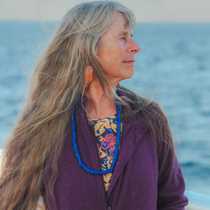Isla Partida, Ensenada Grande
The National Geographic Sea Bird left the dock in La Paz at approximately 4:30am making her way north towards our morning anchorage. The El Norte wind had continued to blow throughout the night and was predicted to continue during our entire first day. Our Expedition Leader had decided to make a short journey of three hours north into the Sea of Cortez or Gulf of California to Isla Partida and a particularly beautiful deeply carved bay called Ensenada Grande. This bay has several white sand beaches, deep aquamarine waters, and some very interesting geology.
Our morning was spent hiking and kayaking from one of the many white sand beaches. The long hike took the morning to climb over and around many boulders to the top of the arroyo for a spectacular view. Medium and leisure hikes were offered, exploring the floor of the arroyo that, due to recent late summer hurricanes, is filled with plants.
The southern part of the Sonoran Desert has two very distinctive weather patterns. In the summer months, the rains and storms fall hard upon the land. These Chubasco storms bring torrents of rain and wind, often filling the arroyos with water. In the winter, the weather comes in the form of wind (in the early winter) and also very light rains called Equipatas. Translated, this means “the sound of horses’ hoofs.” Depending upon the amount and timing of the rain, the plants of this part of the desert can respond with a profusion of growth.
Everyone who hiked into the arroyo of Ensenada Grande was immediately engulfed in vines and shrubs bursting with leaves and some in flower with a bevy of butterflies hovering and landing in search of nourishment. It was visual treat for all! Hikers traded out, and enjoyed kayaking while kayakers entered the botanical treasure of this well watered arroyo and all the cacti, shrubs, small plants and vines bursting with leaf and flower.
Once morning activities were complete everyone returned to the National Geographic Sea Bird for a barbeque deck lunch. The ship remained at anchor inside the calm waters of Ensenada Grande during lunch while the ship’s officers and Expedition Leader decided between moving out into a very windy gulf or remaining inside protected waters. After lunch announcements were made and we were remaining at anchor for the remainder of the day and evening.
Snorkeling was offered in the early afternoon along with Zodiac rides throughout the large bay system that makes up Ensenada Grande. Our trip in the waters of the Sea of Cortez began just after the full moon and two weeks after the winter solstice. The days are getting longer but in small increments. The last two hours of light are beautiful at this latitude and each Zodiac chose its path following the slowly setting sun along the fabulously carved cliffs of the bay.
The weathering pattern in geologic terms is called Tafoni weathering. It is an Italian word, meaning “windows,” and usually occurs in saline moisture environments. Looking at the lacework that makes up this heavily eroded and weathered landscape it is easy to see why it is described in this way.
As the sun moved to shades of gold and orange, the Sally light foot crabs came out near the edges of sculpted cliffs to enjoy their evening meal, their brightly colored shells made even more vivid in the last light of the day. Birds began their evening hunting as prey fish came closer to the surface and the occasional Brown pelican sat surveying its world at sunset.
The protected waters of the bay were a mixture of pink from the rocks, deep blue from the sky and gold from the setting sun. We all remained as long as we could, either on the decks of the anchored National Geographic Sea Bird or in a Zodiac watching an unforgettable rich desert landscape falling into the sea, a combination both unusual and unique.




